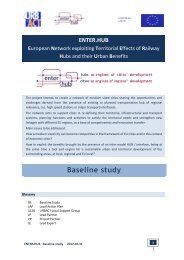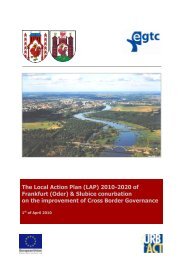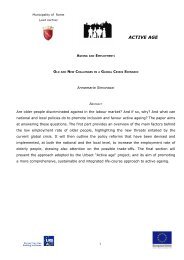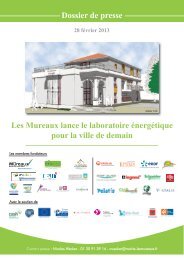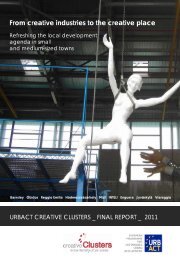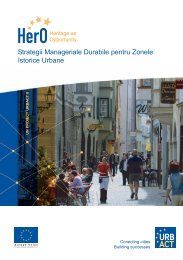Cities of Tomorrow – Action Today. URBACT II Capitalisation. Key ...
Cities of Tomorrow – Action Today. URBACT II Capitalisation. Key ...
Cities of Tomorrow – Action Today. URBACT II Capitalisation. Key ...
Create successful ePaper yourself
Turn your PDF publications into a flip-book with our unique Google optimized e-Paper software.
May 2013<br />
<strong>Cities</strong> <strong>of</strong> <strong>Tomorrow</strong> <strong>–</strong> <strong>Action</strong> <strong>Today</strong><br />
<strong>URBACT</strong> <strong>II</strong> CAPITALISATION<br />
<strong>Key</strong> messages<br />
Shrinking cities:<br />
challenges and<br />
opportunities<br />
<strong>URBACT</strong> <strong>II</strong><br />
SUPPORTING URBAN YOUTH<br />
THROUGH SOCIAL INNOVATION<br />
Building energy<br />
efficiency in<br />
European cities<br />
Against divided<br />
cities in Europe<br />
Motivating mobility<br />
mindsets<br />
More jobs:<br />
better cities
<strong>Cities</strong> <strong>of</strong> <strong>Tomorrow</strong> <strong>–</strong> <strong>Action</strong> <strong>Today</strong>. <strong>URBACT</strong> <strong>II</strong> <strong>Capitalisation</strong>. <strong>Key</strong> messages<br />
Published by <strong>URBACT</strong><br />
5, Rue Pleyel, 93283 Saint-Denis, France<br />
Tel. +33 1 49 17 46 08<br />
Fax: +33 1 49 17 45 55<br />
webassistance@urbact.eu<br />
http://urbact.eu<br />
May 2013<br />
Publication manager: Emmanuel Moulin<br />
Author: Paul Soto<br />
Editorial Advisory Group: Emmanuel Moulin, Melody Houk, Jenny Koutsomarkou<br />
Editing: Toby Johnson<br />
Graphic design and artwork: Phoenix Design Aid A/S (Denmark)<br />
Printing: bialec, Nancy (France)
<strong>Cities</strong> <strong>of</strong> <strong>Tomorrow</strong> <strong>–</strong> <strong>Action</strong> <strong>Today</strong><br />
<strong>URBACT</strong> <strong>II</strong> CAPITALISATION<br />
<strong>Key</strong> messages<br />
Paul Soto
Contents<br />
Foreword............................................................................................................................ 3<br />
Introduction........................................................................................................................ 4<br />
Focusing urban strategies on the levers <strong>of</strong> change............................................................. 8<br />
Completing the bridges between policies and actions........................................................ 10<br />
Realigning existing resources to meet real needs................................................................ 13<br />
Tackling the real barriers to change..................................................................................... 14<br />
Investing in people.............................................................................................................. 15<br />
Creating a new breed <strong>of</strong> urban ‘innovation brokers’........................................................... 16<br />
Conclusion: some ideas for the next generation <strong>of</strong> integrated sustainable<br />
urban development............................................................................................................. 18<br />
References.......................................................................................................................... 20
Foreword<br />
The ‘<strong>Cities</strong> <strong>of</strong> <strong>Tomorrow</strong>’ reflection process, which I initiated in<br />
2010, culminated in a report which provided inspiration for urban<br />
development policy-makers and practitioners alike, whether at local,<br />
regional, national or European level. It is good to see <strong>URBACT</strong> now<br />
taking on the challenges it outlined, and through its broad network<br />
<strong>of</strong> urban experts and city partners, trying to find possible solutions.<br />
<strong>URBACT</strong> is building on the lessons learnt during these years <strong>of</strong> work,<br />
including last year’s conference in Copenhagen, while working closely with other EU-funded programme<br />
partners in ESPON, INTERACT, INTERREG IVC, European cities associations such as EUROCITIES and<br />
Energy <strong>Cities</strong>, and the OECD.<br />
In this way, <strong>URBACT</strong> is actively seeking concrete solutions to the following interlinked challenges that<br />
rank high on the agenda <strong>of</strong> European cities: shrinking cities, more jobs for better cities, supporting young<br />
people through social innovation, divided cities, motivating mobility mind-sets, building energy efficiency.<br />
I am pleased to present this series <strong>of</strong> reports that provide evidence <strong>of</strong> sustainable urban development<br />
strategies pulling together the environmental, social and economic pillars <strong>of</strong> the Europe2020, while also<br />
adopting an integrated and participative approach, essential in these times <strong>of</strong> scarce public resources.<br />
More than ever, cities need an ‘agenda for change’ to focus on decisive action that will boost growth,<br />
to tap into their existing potential, and to rethink their priorities. Better governance, intelligence and<br />
changing <strong>of</strong> the collective consciousness are all part <strong>of</strong> it. <strong>Cities</strong> <strong>of</strong> tomorrow need action today. <strong>URBACT</strong><br />
is all supporting cities to make this happen so… don’t be left behind!<br />
Johannes Hahn<br />
Member <strong>of</strong> the European Commission in charge <strong>of</strong> Regional Policy
Introduction<br />
In October 2011, the European Commission<br />
published a far-reaching and quite visionary<br />
report called <strong>Cities</strong> <strong>of</strong> <strong>Tomorrow</strong> <strong>–</strong> Challenges,<br />
visions, ways forward (European Commission,<br />
DG Regional Policy 2011). The economic and<br />
financial crisis had clearly intensified many urban<br />
problems and exposed the limits <strong>of</strong> existing<br />
policies. In particular, the limits <strong>of</strong> sectoral policies<br />
in seeking to preserve the polycentric, balanced,<br />
socially inclusive and culturally sensitive European<br />
model <strong>of</strong> urban development had become clear.<br />
An integrated, cross-sectoral and territorial<br />
approach, based on two decades <strong>of</strong> European<br />
experience on urban policy distilled into the urban<br />
acquis, was called for.<br />
In this context, the aim <strong>of</strong> the report was to<br />
examine the possible impact <strong>of</strong> a series <strong>of</strong> major<br />
trends on different types <strong>of</strong> European cities in<br />
the coming years. The report identifies four main<br />
threats to the European urban development<br />
model, as the diagram below shows: demographic<br />
decline, threats to economic development and<br />
competitiveness, growing social polarisation and<br />
the depletion <strong>of</strong> natural resources.<br />
These threats are global rather than urban and<br />
they are serious enough to put in question whether<br />
Europe will be able to maintain its relatively<br />
balanced and socially inclusive urban structure in<br />
the face <strong>of</strong> the megacities <strong>of</strong> the East and Latin<br />
America and the more ‘disposable’ cities <strong>of</strong> the<br />
USA. In response to the threats, <strong>Cities</strong> <strong>of</strong> <strong>Tomorrow</strong><br />
presents an attractive vision <strong>of</strong> the opportunities<br />
and potential <strong>of</strong> European cities. It also insists on<br />
the crucial role that cities themselves can play in<br />
finding solutions and thereby contributing to the<br />
goals <strong>of</strong> the Europe 2020 strategy.<br />
However, the <strong>Cities</strong> <strong>of</strong> <strong>Tomorrow</strong> report leaves<br />
open most <strong>of</strong> the questions about what cities<br />
can do to put their potential into practice.<br />
This is the task taken up by six ‘workstreams’<br />
launched by <strong>URBACT</strong> at the beginning <strong>of</strong> 2012.<br />
Each workstream deals with a theme which corresponds<br />
with one <strong>of</strong> the threats identified by <strong>Cities</strong><br />
<strong>of</strong> <strong>Tomorrow</strong> and, over the period <strong>of</strong> a year, has<br />
brought together evidence from <strong>URBACT</strong> projects<br />
but also from a wide range <strong>of</strong> stakeholders from<br />
all around Europe.<br />
Threats (CoT)<br />
Demographic decline<br />
Economic development &<br />
competitiveness<br />
under pressure<br />
Growing<br />
social polarisation<br />
Depletion <strong>of</strong><br />
natural ressources<br />
Responses<br />
6 <strong>URBACT</strong><br />
Workstreams<br />
Workstream 1<br />
Workstream 2<br />
Workstream 3<br />
Workstream 4<br />
Workstream 5<br />
Workstream 6<br />
Shrinking cities &<br />
demographic change<br />
More jobs:<br />
better cities<br />
Supporting urban<br />
youth through<br />
social innovation<br />
Against divided cities<br />
in Europe<br />
Motivating mobility<br />
mindsets<br />
Building<br />
energy efficiency in<br />
European cities<br />
4 <strong>URBACT</strong> <strong>II</strong> <strong>Capitalisation</strong>
<strong>Cities</strong> <strong>of</strong> <strong>Tomorrow</strong> <strong>–</strong> <strong>Action</strong> <strong>Today</strong>. <strong>URBACT</strong> <strong>II</strong> <strong>Capitalisation</strong>. <strong>Key</strong> messages<br />
The end result <strong>of</strong> this collective reflection was the<br />
production <strong>of</strong> six thematic reports. The first two<br />
<strong>of</strong> these reports respond to the underlying problems<br />
<strong>of</strong> the competitive ness <strong>of</strong> European cities<br />
and their growth and decline:<br />
Workstream 1 <strong>–</strong> Shrinking cities: challenges and<br />
opportunities <strong>–</strong> points out that population decline<br />
is a fact <strong>of</strong> life for 40% <strong>of</strong> small and medium-sized<br />
European cities. Rather than denying the reality <strong>of</strong><br />
socio-economic decline, or trying to hold back the<br />
tide <strong>of</strong> rapid population loss and deindustrialisation<br />
with policies which were effective in times <strong>of</strong><br />
prosperity, shrinking cities need to adopt a new<br />
realism in strategy development. An objective<br />
assessment <strong>of</strong> current strengths and weaknesses<br />
is <strong>of</strong>ten urgently required to pave the way for the<br />
substantial adjustments required to create and<br />
then benefit from the opportunities that shrinkage<br />
affords.<br />
Workstream 2 <strong>–</strong> More jobs: better cities <strong>–</strong> takes<br />
a similarly long-term view <strong>of</strong> the challenge for<br />
cities posed by massive rises in unemployment. The<br />
report provides a systemic framework for helping<br />
cities to understand the points at which they can<br />
best intervene in the labour market to build more<br />
and better jobs.<br />
Two more reports deal with the growth in both<br />
social and spatial polarisation that accompanies<br />
recent urban development:<br />
Workstream 3 <strong>–</strong> Supporting urban youth<br />
through social innovation: stronger together<br />
<strong>–</strong> takes the threat <strong>of</strong> unemployment one step<br />
further by pointing to the risk <strong>of</strong> the permanent<br />
marginalisation <strong>of</strong> many young people and<br />
“the development <strong>of</strong> closed subcultures with<br />
fundamentally hostile attitudes to mainstream<br />
society”. In times <strong>of</strong> austerity, the report provides<br />
evidence <strong>of</strong> how cities can work with young people<br />
and other stakeholders to provide more effective<br />
services through a process <strong>of</strong> social innovation.<br />
Workstream 4 <strong>–</strong> Against divided cities in Europe <strong>–</strong><br />
points out that “spatial segrega tion is the projection<br />
<strong>of</strong> the social structure on space” and therefore<br />
cities need to disentangle the processes that lead<br />
to the creation <strong>of</strong> deprived neighbourhoods and<br />
the roles that they play within the city as a whole.<br />
The solution lies in a careful blend <strong>of</strong> area-based<br />
neighbourhood policies and city-wide (or larger<br />
scale) people-based policies. This, in turn, means<br />
that cities have to cooperate with higher levels <strong>of</strong><br />
government and also with other stakeholders.<br />
The two last papers deal with the urban<br />
contribution to some <strong>of</strong> the major threats to the<br />
envi ronment:<br />
Workstream 5 <strong>–</strong> How cities can motivate mobility<br />
mindsets <strong>–</strong> argues provocatively that many <strong>of</strong> the<br />
technical solutions to getting around sustainably<br />
in towns are known, but are simply not put into<br />
practice. Many new mobility solutions for the <strong>Cities</strong><br />
<strong>of</strong> <strong>Tomorrow</strong> will be found through a ‘do-morewith-less’<br />
strategy. By optimising the use <strong>of</strong><br />
existing infrastructure, building on the knowledge<br />
<strong>of</strong> tried and tested solutions and focusing on s<strong>of</strong>t<br />
measures that encourage behavioural change,<br />
cities can develop local policies that provide sound<br />
mobility choices.<br />
Workstream 6 <strong>–</strong> Building energy efficiency in<br />
European cities <strong>–</strong> points to the immense economic<br />
and environmental benefits <strong>of</strong> comprehensive<br />
programmes for the energy efficient retr<strong>of</strong>itting<br />
<strong>of</strong> buildings. Once again, many <strong>of</strong> the technical<br />
solutions already exist but various barriers prevent<br />
the necessary investment taking place. In order to<br />
seize the opportunity, cities need to identify and<br />
find ways around these blockages.<br />
The participative methodology used by each<br />
workstream varied according to the problem<br />
being dealt with and is interesting in its own right.<br />
All <strong>of</strong> them involved a sequence <strong>of</strong> meetings and<br />
hearings over a period <strong>of</strong> roughly nine months<br />
<strong>URBACT</strong> <strong>II</strong> <strong>Capitalisation</strong><br />
5
during which city practitioners, policy experts<br />
and academics pooled the available evidence and<br />
their personal knowledge. One <strong>of</strong> main values<br />
<strong>of</strong> the workstreams was that, for the first time,<br />
they brought together the latest insights from<br />
<strong>URBACT</strong> with evidence from projects from other<br />
European Territorial Cooperation programmes<br />
such as ESPON, INTERACT and INTERREG IVC,<br />
international orga nisations such as the OECD,<br />
EUROCITIES, CECODHAS, CIVITAS, Energy <strong>Cities</strong><br />
and many more.<br />
Given the magnitude and the complexity <strong>of</strong> the<br />
issues raised, the six thematic reports do not<br />
pretend to have all the answers. They start to<br />
make suggestions about what cities can do on<br />
their own, and what changes are required at other<br />
levels, and also make some points about how<br />
these changes can be brought about. These ideas<br />
should be seen as part <strong>of</strong> an ongoing debate about<br />
the priorities for European cities in the (hopefully)<br />
post-crisis period that leads into the next EU<br />
programming period.<br />
The diagram below shows how integrated<br />
strategies for dealing with the urban challenges<br />
covered by the workstreams can produce results<br />
in terms <strong>of</strong> the eleven strategic objectives <strong>of</strong><br />
the European Commission’s Common Strategic<br />
Framework. Through the example <strong>of</strong> energy efficiency,<br />
the diagram also shows how it is possible<br />
to draw out some <strong>of</strong> the main linkages between<br />
the workstreams.<br />
Links between CSF thematic objectives and urban challenges<br />
(example <strong>of</strong> energy efficiency)<br />
2. ICT 3. SMEs<br />
1. Innovation<br />
4. Low Carbon<br />
Shrinking<br />
Jobs<br />
11. Governance<br />
Youth/<br />
Inclusion<br />
URBAN<br />
CHALLENGES<br />
Spatial<br />
Segregration<br />
5. Climate<br />
10. Skills<br />
Mobility<br />
Energy<br />
efficiency<br />
6. Resource<br />
Efficiency<br />
SFF Thematic Objectives:<br />
9. Poverty<br />
8. Employment<br />
7. Transport<br />
1. Innovation<br />
2. ICT<br />
3. SMEs<br />
4. Low Carbon<br />
5. Climate<br />
6. Resource Efficiency<br />
7. Transport<br />
8. Employment<br />
9. Poverty<br />
10. Skills<br />
11. Governance<br />
6 <strong>URBACT</strong> <strong>II</strong> <strong>Capitalisation</strong>
<strong>Cities</strong> <strong>of</strong> <strong>Tomorrow</strong> <strong>–</strong> <strong>Action</strong> <strong>Today</strong>. <strong>URBACT</strong> <strong>II</strong> <strong>Capitalisation</strong>. <strong>Key</strong> messages<br />
©Tanatat-Dreamstime.com<br />
However, the main added value <strong>of</strong> urban<br />
integrated sustainable development lies precisely<br />
in the fact that cities themselves are able to find<br />
ways <strong>of</strong> developing integrated policies which<br />
meet their particular circumstances. This means<br />
that they should be able to build on the positive<br />
synergy between policy fields, while mitigating<br />
the negative externalities that individual sectoral<br />
policies can have on other policy areas (e.g. rapid<br />
economic growth impacting on environmental<br />
protection). <strong>Cities</strong> have to have sufficient margin<br />
for manoeuvre to respond to local needs if they are<br />
to fulfil their potential for connecting with citizens<br />
and supporting the successful implementation<br />
<strong>of</strong> the Europe 2020 strategy. This means that<br />
within the broad objectives set by each national<br />
or regional operational programme, cities need to<br />
be able to decide which challenges and thematic<br />
objectives are most important for them, the<br />
priority they want to give to each (in other words<br />
the relative size <strong>of</strong> the budget) and how best to<br />
deal with them in an integrated way (their specific<br />
strategy). This applies to all the proposed new tools<br />
for integrated sustainable urban development:<br />
separate programmes, dedi cated axes within<br />
programmes, Integrated Territorial Investment and<br />
Community-Led Local Development.<br />
Interested readers can get a quick overview<br />
<strong>of</strong> the content <strong>of</strong> these papers from the short<br />
abstracts and executive summaries at the start<br />
<strong>of</strong> each <strong>of</strong> them. In the rest <strong>of</strong> this paper we will<br />
highlight some <strong>of</strong> the main points they make <strong>–</strong><br />
with a particular focus on those that are relevant<br />
for cities concerned with supporting integrated<br />
sustainable urban development in the next round<br />
<strong>of</strong> EU programmes.<br />
<strong>URBACT</strong> <strong>II</strong> <strong>Capitalisation</strong><br />
7
Focusing urban strategies on the<br />
levers <strong>of</strong> change<br />
The <strong>Cities</strong> <strong>of</strong> <strong>Tomorrow</strong> report and many <strong>of</strong> the<br />
<strong>URBACT</strong> thematic reports open with statements<br />
about the relative importance <strong>of</strong> cities and the<br />
degree to which they concentrate both problems<br />
and opportunities.<br />
“More than two-thirds <strong>of</strong> the<br />
European population lives in<br />
cities. <strong>Cities</strong> are places where<br />
both the problems emerge and<br />
the solutions are found. They<br />
are fertile ground for science<br />
and technology, for culture<br />
and innovation, for individual<br />
and collective creativity and<br />
for mitigating the impact <strong>of</strong><br />
climate change. However, they<br />
are also places where problems<br />
such as unemployment,<br />
segregation and poverty are<br />
concentrated”.<br />
<strong>–</strong> Johannes Hahn. Preface to <strong>Cities</strong> <strong>of</strong> <strong>Tomorrow</strong>.<br />
But given the global nature <strong>of</strong> the challenges, are<br />
cities the central actors? Or are they simply the<br />
stage upon which the drama relentlessly unfolds?<br />
What do cities in fact have the power to change,<br />
and how? Most <strong>of</strong> the thematic reports approach<br />
this issue with what can be called a ‘new realism’<br />
and a plea for a deeper analysis <strong>of</strong> the nature <strong>of</strong><br />
each problem and the source <strong>of</strong> the underlying<br />
causes that bring it about. This in turn requires<br />
improved intelligence and metrics.<br />
A broader strategic analysis is particularly<br />
important when considering what margin for<br />
manoeuvre cities have to influence their economic<br />
competitiveness and the long-term trends in their<br />
demographic growth or decline. For example,<br />
<strong>Cities</strong> <strong>of</strong> <strong>Tomorrow</strong> states that “74% <strong>of</strong> the<br />
differences in growth in GDP between individual<br />
cities in Europe is accounted for by differences in<br />
the growth rates <strong>of</strong> different countries”.<br />
This is reflected in the findings <strong>of</strong> the thematic<br />
report More jobs: better cities, which recognise<br />
that “whilst economic development and employment<br />
is seen as a normal city function in some<br />
parts <strong>of</strong> Europe, it is not in others. Many cities do<br />
not have access to all the relevant policy levers<br />
that could potentially make a difference, as many<br />
key policy decisions are taken at the national and<br />
international levels” (Campbell et al. 2013:11).<br />
But the recommendation in the thematic reports<br />
is not to sit back and do nothing. If cities only have,<br />
for example, a 26% margin for manoeuvre then<br />
there is an even greater rationale for cities to think<br />
more strategically, to target precisely those fields<br />
that they can influence and to “prioritise what<br />
they do and how they do it in order to achieve<br />
maximum impact” (ibid).<br />
This theme is also taken up in the analysis <strong>of</strong><br />
shrinking cities. <strong>Cities</strong> <strong>of</strong> <strong>Tomorrow</strong> identifies<br />
two categories <strong>of</strong> shrinking: firstly, even though<br />
their economies are relatively strong, many small<br />
and medium-sized cities in Europe are expected<br />
to lose population to the larger, internationally<br />
connected metropolises. The report argues that<br />
“with the right policies this kind <strong>of</strong> shrinkage<br />
does not necessarily create problems”. However,<br />
many cities in the Central and Eastern parts <strong>of</strong><br />
Europe, the peripheral parts <strong>of</strong> Western Europe<br />
and many old industrial regions are suffering from<br />
8 <strong>URBACT</strong> <strong>II</strong> <strong>Capitalisation</strong>
<strong>Cities</strong> <strong>of</strong> <strong>Tomorrow</strong> <strong>–</strong> <strong>Action</strong> <strong>Today</strong>. <strong>URBACT</strong> <strong>II</strong> <strong>Capitalisation</strong>. <strong>Key</strong> messages<br />
a combination <strong>of</strong> economic and demographic<br />
decline which is very difficult to deal with.<br />
This is the subject <strong>of</strong> the <strong>URBACT</strong> thematic<br />
report on shrinking cities which points out that<br />
one <strong>of</strong> the most common responses to shrinking<br />
is denial. A number <strong>of</strong> cases are presented which<br />
illustrate that new economic development<br />
cannot be the only answer to reverse the cycle<br />
<strong>of</strong> decline. There is much evidence which shows<br />
that large-scale public investments and grandiose<br />
infrastructure projects, on their own, are unable<br />
to reverse the impact <strong>of</strong> industrial restructuring<br />
and demographic change. The report argues that<br />
“many shrinking cities invest significant resources<br />
in the maintenance or ‘conservation’ <strong>of</strong> what they<br />
perceive to be their strategically important socioeconomic<br />
assets, and define goals which are more<br />
a reflection <strong>of</strong> the city’s prosperous past than its<br />
likely future” (Schlappa & Neill, 2013:12).<br />
The workstream calls for a paradigm shift from<br />
growth-orientated planning to ‘smart shrinking’<br />
(ibid.:12) which could be brought about by<br />
better understanding the cyclical nature <strong>of</strong> urban<br />
development and decline. A model intended to<br />
help cities locate their current position in the<br />
development cycle would encourage a process <strong>of</strong><br />
‘re-envisioning’ the future <strong>of</strong> the city in the light<br />
<strong>of</strong> a more realistic assessment <strong>of</strong> its assets and<br />
opportunities. Crucially, such a re-envisioning<br />
process needs to take account <strong>of</strong> two dimensions:<br />
firstly, the broader regional and national context<br />
in which the city operates; and secondly, a deep<br />
dialogue with local stakeholders. The report goes<br />
on to provide a series <strong>of</strong> practical examples which<br />
illustrate why and how cities have adapted their<br />
physical environment and service provision, with<br />
a special attention to ageing populations.<br />
The <strong>URBACT</strong> thematic report Against divided<br />
cities in Europe also argues that the challenge <strong>of</strong><br />
segregated, deprived neighbourhoods cannot be<br />
tackled solely through the policies which cities<br />
directly control. This means that, in some instances,<br />
cities have to step out from the narrow field<br />
assigned to them by higher levels <strong>of</strong> government.<br />
The report urges cities to lobby for appropriate<br />
national policies while at the same time initiating<br />
bottom-up urban regeneration policies in urban<br />
areas with the participation <strong>of</strong> the main players.<br />
Barcelona. ©Petar Neychev-Dreamstime.com<br />
All <strong>of</strong> the thematic reports argue that the starting<br />
point for seriously addressing the key challenges<br />
identified by <strong>Cities</strong> <strong>of</strong> <strong>Tomorrow</strong> must be a<br />
participative and strategic reassessment <strong>of</strong> the<br />
real barriers that cities face, and the levers they<br />
have available to them to achieve change.<br />
<strong>URBACT</strong> <strong>II</strong> <strong>Capitalisation</strong><br />
9
Completing the bridges between<br />
policies and actions<br />
One <strong>of</strong> the main goals <strong>of</strong> the European Commission’s<br />
proposals for the next round <strong>of</strong> EU funding is to<br />
pay more attention to results by improving both<br />
the strategic focus <strong>of</strong> programmes and policy<br />
coordination and integration. At least 5% <strong>of</strong> the<br />
ERDF budget in each Member State should be<br />
reserved for integrated actions for sustainable<br />
urban development. However, all the <strong>URBACT</strong><br />
thematic reports point to the need for a much<br />
more nuanced and sophisticated interpretation <strong>of</strong><br />
integration than is used at present.<br />
Firstly, all the reports recommend taking an<br />
integrated approach within the particular thematic<br />
field or challenge that they are dealing with. For<br />
example, the report on More Jobs: Better cities<br />
produces a systemic framework for analysing city<br />
labour markets and helping cities to identify and<br />
prioritise the policy levers where they have the<br />
greatest chances <strong>of</strong> achieving long-term results<br />
in terms <strong>of</strong> jobs.<br />
The diagram below, drawn from the thematic<br />
report More jobs: better cities (Campbell et al.<br />
2013), shows that this means integrating policies<br />
concerned with economic development with<br />
policies concerned with the labour market per se.<br />
This in turn involves bringing together stakeholders<br />
as diverse as private firms, large public institutions,<br />
economic development agencies, research bodies,<br />
chambers <strong>of</strong> commerce, universities, schools,<br />
training establishments, social services and so on.<br />
Nevertheless, this kind <strong>of</strong> thematic integration<br />
basically focuses on the most important policies<br />
and stakeholders required to deal with a particular<br />
urban challenge <strong>–</strong> in this case unemployment <strong>–</strong><br />
even if it is embedded within a broader strategy<br />
for the whole city.<br />
Outline framework for city actions on jobs<br />
Intelligence<br />
JOBS and the<br />
ECONOMY<br />
(PRODUCT MARKET)<br />
Information<br />
Evidence<br />
PEOPLE<br />
(LABOUR MARKET)<br />
Demand<br />
Competitiveness<br />
Economic<br />
structure<br />
ECONOMIC GROWTH & DEVELOPMENT<br />
LABOUR MARKET MANAGEMENT<br />
Capacity<br />
Collaboration<br />
Quality jobs<br />
Labour mobility<br />
Skills<br />
Governance<br />
Source: Campbell, M. & Partridge, A. with Soto, P. (2013)<br />
10 <strong>URBACT</strong> <strong>II</strong> <strong>Capitalisation</strong>
<strong>Cities</strong> <strong>of</strong> <strong>Tomorrow</strong> <strong>–</strong> <strong>Action</strong> <strong>Today</strong>. <strong>URBACT</strong> <strong>II</strong> <strong>Capitalisation</strong>. <strong>Key</strong> messages<br />
This kind <strong>of</strong> integrated or systemic approach<br />
to a specific problem can be very helpful for<br />
cities considering how best to use the new tools<br />
for integrated sustainable urban development<br />
proposed for the next programming period (for<br />
example, Integrated Territorial Investments and<br />
Community-Led Local Development). It shows<br />
that cities do not have to risk biting <strong>of</strong>f more than<br />
they can chew by trying to deal with everything<br />
at once, but that they can use the tools proposed<br />
by the Commission for integrated territorial development<br />
to focus on a limited number <strong>of</strong> strategic<br />
objectives in an integrated way as long as this<br />
forms part <strong>of</strong> a broader strategy for the whole<br />
city.<br />
Secondly, the reports provide some dramatic<br />
examples <strong>of</strong> the potential for building on the<br />
horizontal linkages between policy areas. The<br />
<strong>URBACT</strong> report Building energy efficiency in<br />
European cities argues that the energy-efficient<br />
retr<strong>of</strong>itting <strong>of</strong> existing buildings represents “one<br />
<strong>of</strong> the largest and most important opportunities<br />
for Europe to expand economic growth and<br />
job creation” (Owen Lewis et al. 2013:25). As<br />
well as “reduc[ing] energy costs for businesses<br />
and households <strong>of</strong> all income levels, reduc[ing]<br />
emissions and improv[ing] energy security”<br />
(ibid.), it is estimated that this policy could<br />
create between 760,000 and 1,480,000 jobs<br />
(Copenhagen Economics 2012:6). In fact, all the<br />
reports provide evidence <strong>of</strong> the way in which<br />
sustainable urban development strategies can pull<br />
together the environmental, social and economic<br />
pillars <strong>of</strong> the Europe 2020 strategy. However, this<br />
requires the flexibility to be able to respond to<br />
local circumstances.<br />
Thirdly, and perhaps less obviously, several <strong>of</strong> the<br />
reports point to the need to take into account<br />
possible negative feedback between policy<br />
fields. Non-integrated approaches can have<br />
damaging impacts for other policy areas. For<br />
example, the report on Mobility mindsets argues<br />
that poorly designed urban transport policies can<br />
lead to “mobility poverty [which] can accelerate<br />
unemployment, accentuate the creation <strong>of</strong><br />
dilapidated neighbourhoods, increase social<br />
exclusion and spatial segregation, and exacerbate<br />
poor health” (Enemark & Kneeshaw 2013:9).<br />
Similarly, the report on Building energy efficiency<br />
points out that 12% <strong>of</strong> all households are living in<br />
fuel poverty and this “affects the efficiency <strong>of</strong> the<br />
health service, child poverty, educational ability<br />
and productivity” (Owen Lewis et al. 2013:31).<br />
Therefore, strategies for sustainable urban<br />
development which target particular thematic<br />
objectives also need to be designed sensitively to<br />
take account <strong>of</strong> possible negative side-effects.<br />
Also the potential for real win-wins and gains from<br />
optimal integration needs to be explored (these<br />
could be worked out through multi-stakeholder<br />
policy intelligence, as mentioned in section 2<br />
above). Once again cities need the flexibility to<br />
be able to work creatively on the multipliers that<br />
cross thematic boundaries.<br />
Finally, most <strong>of</strong> the reports also argue that policies<br />
to deal with the key urban challenges identified<br />
in <strong>Cities</strong> <strong>of</strong> <strong>Tomorrow</strong> need to be integrated into<br />
broader multi-level strategies. For example, the<br />
workstream Against divided cities argues that<br />
“many problems do not originate in deprived<br />
areas, but result from wider societal structures<br />
and developments. Thus they cannot be solved<br />
exclusively in the areas where they are more<br />
visi ble: they require a multilevel intervention<br />
method” (Colini et al. 2013:6). <strong>Cities</strong> are invited<br />
first to consider “the types and problems <strong>of</strong><br />
given areas <strong>–</strong> for example are they dead-end or<br />
<strong>URBACT</strong> <strong>II</strong> <strong>Capitalisation</strong><br />
11
transitory areas? The second is to understand<br />
the dynamism <strong>of</strong> the process <strong>–</strong> in which direction<br />
are they heading? ... A typical mistake cities<br />
make is to judge neighbourhoods on the basis <strong>of</strong><br />
static measures, and to focus on policies which<br />
undermine the role the area plays in the city in a<br />
dynamic sense” (ibid.).<br />
networks. However, in the majority <strong>of</strong> countries,<br />
there are important policy gaps which make it<br />
difficult for cities to develop policy initiatives<br />
that achieve their full impact. The future round<br />
<strong>of</strong> EU programmes also provides an opportunity<br />
for addressing some <strong>of</strong> these gaps at regional and<br />
national levels.<br />
The conclusion is that place-based neighbourhood<br />
policies are needed but that, on their own, they<br />
may end up doing no more than whitewashing<br />
and shifting deeper structural problems around<br />
the city. In this context, the Commission’s proposals<br />
for a series <strong>of</strong> new tools for integrated<br />
sustainable urban development create the opportunity<br />
for a second generation <strong>of</strong> multilevel<br />
integrated strategies against the division <strong>of</strong> cities,<br />
which combine place-based and people-based<br />
approaches. The report goes on to outline some <strong>of</strong><br />
the key ingredients such strategies could contain.<br />
All the thematic reports support the idea<br />
that exerting a real impact on the main urban<br />
challenges depends on there being a far better<br />
vertical articulation between urban, regional and<br />
national strategies. In some European countries<br />
these linkages are relatively well established and<br />
cities are integrated into regional and national<br />
©Pichayasri - Dreamstime.com<br />
12 <strong>URBACT</strong> <strong>II</strong> <strong>Capitalisation</strong>
<strong>Cities</strong> <strong>of</strong> <strong>Tomorrow</strong> <strong>–</strong> <strong>Action</strong> <strong>Today</strong>. <strong>URBACT</strong> <strong>II</strong> <strong>Capitalisation</strong>. <strong>Key</strong> messages<br />
Realigning existing resources to<br />
meet real needs<br />
The thematic reports have different views on the<br />
politics <strong>of</strong> austerity that characterise the current<br />
phase <strong>of</strong> the crisis. On the one hand certain papers<br />
remind us <strong>of</strong> the immense potential <strong>of</strong> investments<br />
in the environment <strong>–</strong> for the economy, jobs and<br />
social inclusion. For these reasons, the report<br />
on Building energy efficiency argues for a major<br />
increase in the scale <strong>of</strong> renovation <strong>of</strong> the existing<br />
building stock.<br />
But most <strong>of</strong> the reports point to the fact that there<br />
is still room for manoeuvre for improving both<br />
social and environmental outcomes with existing<br />
resources. For example, the report on Motivating<br />
mobility mindsets argues that infrastructure<br />
investment, especially for public transport, is still<br />
crucial in many cities, but at a time <strong>of</strong> austerity,<br />
it needs to be complemented with s<strong>of</strong>t mobility<br />
solutions. A learning process has to take place to<br />
develop a clear vision <strong>of</strong> mobility and to strike a<br />
balance between big infrastructure projects and<br />
smarter elements.<br />
The report accepts that the standards <strong>of</strong> public<br />
infrastructure vary enormously between cities<br />
and that the cities <strong>of</strong> central and eastern European<br />
countries still have a major need for investment.<br />
Nevertheless, the main focus <strong>of</strong> the report is to<br />
provide a series <strong>of</strong> imaginative examples <strong>of</strong> how<br />
cities can optimise the use <strong>of</strong> existing infrastructure,<br />
better plan the use <strong>of</strong> public space and<br />
transfer tried and tested solutions from the frontrunner<br />
cities in this field.<br />
The report on More jobs: better cities follows a<br />
similar line <strong>of</strong> thought: “We need to do less <strong>–</strong> and<br />
do it better. We need to change the way we do<br />
things, how we do them, alter our daily practice<br />
and change the way in which we use and develop<br />
our relation ships” (Campbell et al. 2013:43).<br />
This requires far better shared intelligence and<br />
the mobilisation <strong>of</strong> all concerned actors through<br />
better governance <strong>–</strong> changes which are <strong>of</strong>ten<br />
harder to achieve, and are less tangible, visible or<br />
measurable than opening new buildings and roads.<br />
Against divided cities also argues that the costly<br />
large-scale demolition <strong>of</strong> buildings is <strong>of</strong>ten not the<br />
best solution for deprived urban neighbourhoods.<br />
Demolition is <strong>of</strong>ten the result <strong>of</strong> failure by the<br />
city to apply integrated s<strong>of</strong>t and hard policies<br />
which open up more opportunities for deprived<br />
neighbourhoods and their residents.<br />
Similarly, the report on Shrinking cities and<br />
demographic change discusses putting disused<br />
land and buildings to interim uses, market repositioning<br />
to promote overlooked assets, and<br />
adapting the services on <strong>of</strong>fer to promote<br />
growth in those areas that serve the needs <strong>of</strong> a<br />
different, usually older, population. <strong>Cities</strong> can keep<br />
a com petitive edge by emphasising quality over<br />
quantity in service provision, and by coordinating<br />
with neighbours to avoid wasteful investments in<br />
duplicate facilities. Brownfield redevelopment is<br />
most cost-effective when it is delivered through<br />
public-private partnerships and focused on<br />
middle-ranking sites that are on the borders <strong>of</strong><br />
commercial viability.<br />
<strong>Cities</strong> are well placed to rethink how existing<br />
resources can be aligned to meet real needs. The<br />
workstream on Supporting urban youth argues:<br />
“As the level <strong>of</strong> democratically accountable<br />
government nearest our citizens, they can<br />
assume a key role in reconnecting with them<br />
and in reshaping public services. Specifically, the<br />
opportunity is to ensure that taxpayers’ resources<br />
are focused on priorities and more effectively<br />
invested” (Adams & Arnkil 2013:41).<br />
<strong>URBACT</strong> <strong>II</strong> <strong>Capitalisation</strong><br />
13
Tackling the real barriers<br />
to change<br />
Several <strong>of</strong> the thematic reports point out that<br />
even when the technical solution to a problem is<br />
known, various blockages or barriers may prevent<br />
the market or democratically elected politicians<br />
putting it into practice.<br />
For example, the report on Building energy<br />
efficiency asks “why is it that proven technologies<br />
that are cost-effective are at best only slowly<br />
adopted?” (Owen Lewis et al. 2013:14). It mentions<br />
several market imperfections such as: the<br />
size <strong>of</strong> upfront investments and the length (and<br />
uncertainty) <strong>of</strong> payback periods; the principalagent<br />
problem whereby the benefits <strong>of</strong> energy<br />
conservation do not accrue to the person who<br />
has to make the investment; and the fact that<br />
externalities such as the impact on jobs and<br />
health do not enter the equation. In this regard, it<br />
would certainly help if metrics measured progress<br />
or return on investment across policy fields and<br />
shared objectives, such as CO 2<br />
reduction, health<br />
and job impacts, social cohesion and public spaces<br />
improved. The report argues for an “agenda<br />
for change” which combines more favourable<br />
“national incentive frameworks to overcome market<br />
inertia, secure demand and facilitate private<br />
capital provision” (ibid.:8). Under the umbrella <strong>of</strong><br />
binding targets for energy efficient retr<strong>of</strong>itting,<br />
cities should carry out integrated neighbourhood<br />
retr<strong>of</strong>itting action plans.<br />
In contrast to market imperfections, the report<br />
on Mobility mindsets stresses the fact that<br />
the traditional public policies <strong>of</strong> investment in<br />
infrastructure have not solved the transport<br />
problems <strong>of</strong> most cities. These generally boil down<br />
to too many cars, and associated congestion, CO 2<br />
emis sions and pollution, together with ‘mobility<br />
poverty’ for certain groups and neighbourhoods.<br />
Rather than simply blaming vested interests<br />
or weak politicians, the report argues that the<br />
problem lies deeper, within the general mindsets<br />
or attitudes towards mobility in society as a whole.<br />
The question then becomes what cities can do to<br />
change these mindsets towards a new concept <strong>of</strong><br />
mobility that is consistent with the quality <strong>of</strong> life<br />
and <strong>of</strong> public space, and that encourages citizens<br />
and businesses to make greener choices.<br />
The report provides some ingenious examples <strong>of</strong><br />
how cities have achieved this, and points to the<br />
need to strengthen a series <strong>of</strong> measures, to build<br />
capacity, design new business models, create<br />
part nerships for a better sharing <strong>of</strong> risks and<br />
benefits, break down interdepartmental barriers,<br />
and use ‘change agents’ to involve a wide range<br />
<strong>of</strong> local stakeholders in developing a shared vision<br />
<strong>of</strong> mobility.<br />
Shrinking cities face an analogous challenge<br />
in that they must reframe the issues in ways<br />
that reveal new ways out <strong>of</strong> their dilemma. The<br />
process needs to be one <strong>of</strong> stepping back, locating<br />
the city’s position on the development<br />
cycle, and working out in an open-minded way<br />
how to use the existing assets in ways that suit<br />
the future, not the past. Local leaders need to<br />
engage their populations in dialogue so that they<br />
can understand the problems and trends before<br />
desig ning new paths for development. They also<br />
need to build new alliances.<br />
14 <strong>URBACT</strong> <strong>II</strong> <strong>Capitalisation</strong>
<strong>Cities</strong> <strong>of</strong> <strong>Tomorrow</strong> <strong>–</strong> <strong>Action</strong> <strong>Today</strong>. <strong>URBACT</strong> <strong>II</strong> <strong>Capitalisation</strong>. <strong>Key</strong> messages<br />
Investing in people<br />
The thematic reports reflect a growing recognition<br />
that investment in people rather than just<br />
buildings and land is the main source <strong>of</strong> long-term<br />
competitive advantage for cities. Human capital,<br />
social capital and governance appear to be the<br />
modern gold dust that attracts firms, investment<br />
and yet more skilled people in a virtuous spiral <strong>of</strong><br />
development.<br />
For example, the thematic report on More jobs:<br />
better cities provides a ‘people agenda’ (Campbell<br />
et al. 2013:25) which identifies three main fields<br />
<strong>of</strong> intervention in city labour markets (job quality,<br />
labour mobility and skills) to ensure that urban<br />
growth translates into real opportunities for local<br />
people and to prevent the problems <strong>of</strong> social<br />
polarisation dealt with by other reports. It argues<br />
that skill levels play a major role in explaining<br />
regional economic performance, but that on their<br />
own more skills are not enough. It is also important<br />
to design pathways to ensure that local people<br />
have access to skilled jobs, and career ladders<br />
which allow them to progress from one level to<br />
another <strong>–</strong> rather than being trapped in low paid,<br />
dead-end occupations.<br />
In a similar vein, the thematic report on urban<br />
youth says: “there is growing evidence that the<br />
most successful cities are those which maximise<br />
the potential <strong>of</strong> the human capital available to<br />
them. Given Europe’s demographics … this means<br />
being able to retain, attract and mobilise the talents<br />
<strong>of</strong> our young people” (Adams & Arnkil 2013:9).<br />
However on the contrary in some European cities<br />
unemployment among young people has reached<br />
over 50%, leading to the risk <strong>of</strong> permanently<br />
scarring an entire generation. The report argues<br />
that the crisis has made things dramatically worse<br />
but that a simple return to growth will not halt the<br />
long-term trends towards the disconnection and<br />
disaffection <strong>of</strong> a significant proportion <strong>of</strong> urban<br />
youth.<br />
People are also a crucial factor in energy efficiency<br />
and mobility in cities. It is the changing behaviour<br />
<strong>of</strong> city dwellers that determines the success<br />
or failure <strong>of</strong> a policy to reduce domestic energy<br />
consumption or encourage a switch to sustainable<br />
travel habits. Starting a dialogue with energy and<br />
transport users, and educating them in innovative<br />
alternatives, is a necessary accompaniment to any<br />
physical investments. It may also be necessary<br />
to stimulate the supply side <strong>of</strong> the market for<br />
energy-saving materials, devices and services.<br />
All the reports also stress the importance <strong>of</strong><br />
people in the sense <strong>of</strong> the ‘s<strong>of</strong>t factors’ which<br />
determine good governance. These include the<br />
well-known list <strong>of</strong> principles associated with the<br />
urban acquis and the ‘<strong>URBACT</strong> method’ such as<br />
wide and systematic stakeholder involvement,<br />
partnership working, breaking down policy silos,<br />
multilevel governance, leadership and rigorous<br />
strategic analysis. Assembling all <strong>of</strong> these s<strong>of</strong>t<br />
factors to produce effective strategies also<br />
requires a paradigm shift and capacity building <strong>–</strong><br />
not only at local level, but for stakeholders at all<br />
levels. The ERDF, which has traditionally focused<br />
far more on the physical side <strong>of</strong> investments,<br />
needs to ensure that these s<strong>of</strong>t elements are given<br />
more prominence within strategies for integrated<br />
sustainable urban development.<br />
<strong>URBACT</strong> <strong>II</strong> <strong>Capitalisation</strong><br />
15
Creating a new breed <strong>of</strong> urban<br />
‘innovation brokers’<br />
All the thematic reports share the view that a<br />
simple extension <strong>of</strong> past policies and ‘business<br />
as usual’ is no longer an option. They argue that<br />
a series <strong>of</strong> forces are making a rethinking or<br />
revisioning <strong>of</strong> the city’s role more urgent. These<br />
include:<br />
A deeper understanding <strong>of</strong> the global drivers<br />
shaping cities, the interrelationship between<br />
them and the margin for manoeuvre that this<br />
leaves urban managers.<br />
The cuts in public resources caused by the<br />
policies <strong>of</strong> austerity being pursued in this<br />
phase <strong>of</strong> the crisis.<br />
The economic, social, psychological and<br />
political barriers to putting known solutions<br />
into practice.<br />
The thematic report Supporting urban youth<br />
through social innovation argues that the concept<br />
<strong>of</strong> social innovation can help cities to take many<br />
<strong>of</strong> the s<strong>of</strong>t factors mentioned in the last section<br />
and organise them into a structured approach for<br />
generating change. The report provides practical<br />
examples <strong>of</strong> how cities can improve six <strong>of</strong> the<br />
key conditions for successful social innovation:<br />
the generation <strong>of</strong> new ideas, access to specialist<br />
knowledge, a new evidence base, coproduction<br />
with all stakeholders, new service delivery models<br />
and smart finance.<br />
Most importantly, however, it argues that cities<br />
need to mobilise these ingredients, over time and in<br />
a sequential fashion, to create an ‘innovation spiral’<br />
that minimises risk and increases the chances <strong>of</strong><br />
Revisiting the social innovation process: critical elements<br />
NEW EVIDENCE BASE<br />
NEW IDEAS<br />
2 Proposals<br />
UNUSUAL SUSPECTS<br />
1 Prompts<br />
NEW DELIVERY MODELS<br />
6 Systemic change<br />
NEW EVIDENCE BASE<br />
UNUSUAL SUSPECTS<br />
3 Prototypes<br />
COPRODUCTION<br />
NEW DELIVERY MODELS<br />
SMART FINANCE<br />
4 Sustaining<br />
NEW EVIDENCE BASE<br />
5 Scaling<br />
COPRODUCTION<br />
NEW EVIDENCE BASE<br />
NEW IDEAS<br />
COPRODUCTION<br />
Adapted from Young Foundation (Adam, E & Arnkil, R., 2013:33)<br />
16 <strong>URBACT</strong> <strong>II</strong> <strong>Capitalisation</strong>
<strong>Cities</strong> <strong>of</strong> <strong>Tomorrow</strong> <strong>–</strong> <strong>Action</strong> <strong>Today</strong>. <strong>URBACT</strong> <strong>II</strong> <strong>Capitalisation</strong>. <strong>Key</strong> messages<br />
widespread take-up. As the diagram page 16<br />
shows, change starts small with the prompting <strong>of</strong><br />
the original idea, is tested through pilot proposals<br />
and prototypes, and is then scaled up gradually<br />
until it can bring about systemic change. The<br />
lessons for the future use <strong>of</strong> EU funds in cities<br />
are clear. There should be a far closer, structural<br />
link between the exploratory exchange and<br />
cooperation programmes, small-scale innovatory<br />
actions and mainstream structural investments.<br />
Social innovation also involves a new way <strong>of</strong><br />
looking at the relationship between consumers,<br />
suppliers and workers and between the public,<br />
private and social economy sectors. Public<br />
and private sector workers and suppliers have<br />
detailed knowledge about how things work. On<br />
the other hand, households and citizens can <strong>–</strong> and<br />
do <strong>–</strong> internalise a series <strong>of</strong> functions as diverse<br />
as household maintenance and care as well as<br />
play ing a number <strong>of</strong> roles as active customers<br />
or volunteers. Social innovation aims to mobilise<br />
the full potential <strong>of</strong> all the actors in a system.<br />
Rather than caricaturing the public, private or<br />
social economy sectors as either good or bad, it<br />
tries to promote new formulas for collaboration at<br />
the intersection between each <strong>of</strong> them and the<br />
household economy.<br />
The thematic report Supporting urban youth<br />
through social innovation (Adams & Arnkil<br />
2013:9) argues that “in the future, effective local<br />
authorities are likely to be those which do not<br />
seek to implement, control and fund everything.<br />
Rather, they will assume a brokerage role, enabling<br />
all stakeholders to play to their strengths”. As<br />
mentioned above, the principal challenge lies not<br />
so much in the amount <strong>of</strong> financial resources but<br />
in how to use these funds in a way that “creates a<br />
new set <strong>of</strong> improved relationships with all citizens<br />
including young people in our cities. This will mean<br />
mobilising stake holders <strong>–</strong> service providers, policymakers,<br />
parents and young people themselves <strong>–</strong> to<br />
©Ammit - Dreamstime.com<br />
design and deliver a new generation <strong>of</strong> support<br />
services, based upon trust and optimising our<br />
limited resources. This is our vision for the cohesive<br />
city <strong>of</strong> tomorrow” (ibid.:41).<br />
The same principles apply to the repositioning <strong>of</strong><br />
cities affected by the shrinkage <strong>of</strong> their traditional<br />
economic activities, which need to innovate<br />
their way out <strong>of</strong> the past and into the future, by<br />
inventing new services for a changing population<br />
pr<strong>of</strong>ile. It is to be hoped that cities will be able<br />
to use the new tools for integrated sustainable<br />
urban development proposed by the European<br />
Commission to put visions like this into practice.<br />
<strong>URBACT</strong> <strong>II</strong> <strong>Capitalisation</strong><br />
17
Conclusion: some ideas for the<br />
next generation <strong>of</strong> integrated<br />
sustainable urban development<br />
The <strong>Cities</strong> <strong>of</strong> <strong>Tomorrow</strong> report is a wake-up<br />
call. European cities are ripe with marvellous<br />
opportunities, but these are also under threat.<br />
The crisis has considerably worsened the situation<br />
and dramatically reduced the resources available<br />
to cities, but most <strong>of</strong> the threats are due to longterm<br />
underlying trends that started much earlier.<br />
In this context, to try to continue doing business<br />
as usual is simply burying one’s head in the sand.<br />
Each <strong>of</strong> the six <strong>URBACT</strong> thematic reports referred<br />
to in this paper contains a series <strong>of</strong> specific<br />
examples, ideas and recommendations about how<br />
cities could tackle some <strong>of</strong> the most important<br />
urban challenges in the future. All <strong>of</strong> them,<br />
whether they take the form <strong>of</strong> Sustainable Urban<br />
Mobility Plans (SUMPs), action plans for youth<br />
inclusion, local labour market plans or strategies for<br />
neighbourhood renewal, combined with social mix<br />
strategies across the city and energy retr<strong>of</strong>itting<br />
<strong>–</strong> should be high priorities for EU support through<br />
integrated sustainable urban development.<br />
<strong>Cities</strong> that wish to use the new opportunities<br />
<strong>of</strong>fered by the EU in the near future should<br />
consider the following recommendations from the<br />
workstreams. They should:<br />
Develop an appropriate knowledge base.<br />
Many <strong>of</strong> the problems cities have to deal with<br />
are much more complex than they appear<br />
at first sight. It is crucial to collect evidence<br />
about the real situation and explore the underlying<br />
dynamics <strong>of</strong> development. In order to<br />
identify the problems correctly and gain the<br />
proper depth <strong>of</strong> insight, cities should involve<br />
stakeholders in the provision and evaluation<br />
<strong>of</strong> data and the ongoing monitoring <strong>of</strong> the<br />
consequences <strong>of</strong> interventions.<br />
Mobilise people and resources around the<br />
strategic challenges. Given the scarcity <strong>of</strong><br />
public resources, it does not make sense to<br />
make heavy investments in isolated physical<br />
projects that cannot provide evidence<br />
that they will make a clear contribution to<br />
integrated strategic goals. Human and material<br />
resources need to be combined and<br />
concentrated on the most important problems<br />
and the ones where cities realistically have the<br />
most ability to achieve change.<br />
Rethink the opportunities. Although<br />
they use different terms, all <strong>of</strong> the <strong>URBACT</strong><br />
workstreams suggest that this involves a<br />
process <strong>of</strong> participative rethinking or reenvisioning<br />
the ‘opportunity structures’<br />
available to cities in the light <strong>of</strong> a realistic<br />
assessment <strong>of</strong> both short-term and longterm<br />
trends. In this sense, cities are ideally<br />
pla ced to reconnect with local citizens and<br />
bring together all stakeholders to ensure<br />
a total resource mobilisation more closely<br />
aligned with real needs.<br />
Build bridges between levels and policies.<br />
All workstreams agree that the<br />
re-envisioning process must be deepened in<br />
at least two ways: firstly, in the vertical sense<br />
<strong>of</strong> reinforcing the linkages between urban,<br />
regional and national policies, and secondly,<br />
in the horizontal sense <strong>of</strong> strengthening the<br />
multiplier effects between the environmental,<br />
social and economic pillars <strong>of</strong> sustainable<br />
urban development.<br />
Create clear national and regional frameworks<br />
that empower city action. If cities<br />
are relegated to becoming the last link in a<br />
18 <strong>URBACT</strong> <strong>II</strong> <strong>Capitalisation</strong>
<strong>Cities</strong> <strong>of</strong> <strong>Tomorrow</strong> <strong>–</strong> <strong>Action</strong> <strong>Today</strong>. <strong>URBACT</strong> <strong>II</strong> <strong>Capitalisation</strong>. <strong>Key</strong> messages<br />
top-down command delivery system they<br />
will never fulfil their potential in dealing with<br />
the key urban challenges. In many cases, national<br />
and regional policy is the weakest link in<br />
the chain. It needs to be reinforced <strong>–</strong> but in<br />
a flexible way that empowers cities to take<br />
action and respond imaginatively to local<br />
circumstances. There are also cases where<br />
national or regional policy is the main cause<br />
<strong>of</strong> problems which appear at city level. In such<br />
cases cities have a role to play in promoting<br />
changes at higher policy levels.<br />
Break down the real barriers. Several <strong>of</strong> the<br />
workstreams point out that technical solutions<br />
already exist but that a series <strong>of</strong> barriers<br />
prevent these ideas being implemented. Some<br />
<strong>of</strong> the barriers are due to market and/or public<br />
sector (political) ‘imperfections’, but a large<br />
part <strong>of</strong> the problem lies in the attitudes and<br />
mindsets <strong>of</strong> all <strong>of</strong> us. Smart city strategies<br />
for change need to identify and focus on<br />
overcoming the real barriers that have to be<br />
faced in each city, and not to unquestioningly<br />
follow the latest development fashions.<br />
Put people first. People rather than buildings<br />
hold the key to dealing with the challenges<br />
identified by <strong>Cities</strong> <strong>of</strong> <strong>Tomorrow</strong>. This fact<br />
presents a major challenge for the ERDF,<br />
which tends to concentrate on physical<br />
invest ments. Therefore, independently <strong>of</strong><br />
whether the ERDF works more closely with<br />
the ESF in the future, there is a need to ensure<br />
that integrated strategies for sustainable<br />
deve lopment have the flexibility to design<br />
intelligent combinations <strong>of</strong> people-based and<br />
physical investments that get to the roots <strong>of</strong><br />
the problems they are addressing.<br />
Create spirals <strong>of</strong> change. While there is a<br />
need for emergency measures in many cities,<br />
all <strong>of</strong> the thematic papers agree that the<br />
scope for quick, magical fixes is limited. The<br />
important thing is to start the ball rolling in the<br />
right direction. This requires a combination <strong>of</strong><br />
‘smart’ financial support, physical investments<br />
and people-based policies which take<br />
ideas for change through various stages <strong>of</strong><br />
implementation to their mainstream adoption.<br />
The European Structural and Investment Funds<br />
can play an important role in allowing cities to<br />
put these recommendations into practice. To do<br />
so they need to ensure an articulation between<br />
the different types and stages <strong>of</strong> support<br />
they provide. In particular there must be clear<br />
bridges between early-stage European Territorial<br />
Cooperation (ETC) programmes, innovative<br />
actions, research and development, strategies for<br />
inte grated sustainable urban development and the<br />
mainstream axes <strong>of</strong> the operational programmes.<br />
Last but not least, these recommendations call<br />
for a paradigm shift <strong>–</strong> or at least a change <strong>of</strong><br />
mindsets <strong>–</strong> for all stakeholders at every stage <strong>of</strong><br />
the delivery <strong>of</strong> urban policy and action. This in<br />
turn requires targeted and high-quality capacity<br />
building, the exchange <strong>of</strong> good practices, and a<br />
continuous learning culture at city, regional and<br />
EU levels.<br />
<strong>URBACT</strong> is committed to working with cities,<br />
national authorities and the European Commission<br />
to achieve just such a system in the coming<br />
programming period.<br />
<strong>URBACT</strong> <strong>II</strong> <strong>Capitalisation</strong><br />
19
References<br />
Adams, E. & Arnkil, R. (2013) <strong>Cities</strong> <strong>of</strong><br />
<strong>Tomorrow</strong>-<strong>Action</strong> <strong>Today</strong>, <strong>URBACT</strong> <strong>II</strong><br />
<strong>Capitalisation</strong>, Supporting urban youth through<br />
social innovation: stronger together, Saint-Denis:<br />
<strong>URBACT</strong><br />
Campbell, M. & Partridge, A. with Soto, P. (2013)<br />
<strong>Cities</strong> <strong>of</strong> <strong>Tomorrow</strong>-<strong>Action</strong> <strong>Today</strong>, <strong>URBACT</strong><br />
<strong>II</strong> <strong>Capitalisation</strong>, More jobs: better cities <strong>–</strong> a<br />
framework for city action on jobs, Saint-Denis:<br />
<strong>URBACT</strong><br />
Colini, L., Czischke, D., Güntner, S., Tosics I and<br />
Ramsden P. (2013) <strong>Cities</strong> <strong>of</strong> <strong>Tomorrow</strong>-<strong>Action</strong><br />
<strong>Today</strong>, <strong>URBACT</strong> <strong>II</strong> <strong>Capitalisation</strong>, Against divided<br />
cities in Europe, Saint-Denis: <strong>URBACT</strong><br />
Copenhagen Economics (2012) Multiple benefits<br />
<strong>of</strong> investing in energy efficient renovation <strong>of</strong><br />
buildings. Impact on Public Finances, Copenhagen<br />
Enemark, A. & Kneeshaw, S. (2013) <strong>Cities</strong><br />
<strong>of</strong> <strong>Tomorrow</strong>-<strong>Action</strong> <strong>Today</strong>, <strong>URBACT</strong> <strong>II</strong><br />
<strong>Capitalisation</strong>, How cities can motivate mobility<br />
mindsets, Saint-Denis: <strong>URBACT</strong><br />
European Commission, DG Regional Policy<br />
(2011) <strong>Cities</strong> <strong>of</strong> <strong>Tomorrow</strong> <strong>–</strong> Challenges, visions,<br />
ways forward, Luxembourg: Publications Office<br />
<strong>of</strong> the European Union. http://ec.europa.eu/<br />
regional_policy/conferences/cities<strong>of</strong>tomorrow/<br />
index_en.cfm<br />
Owen Lewis, J., Ní Hógáin, S. & Borghi, A. (2013)<br />
<strong>Cities</strong> <strong>of</strong> <strong>Tomorrow</strong>-<strong>Action</strong> <strong>Today</strong>, <strong>URBACT</strong><br />
<strong>II</strong> <strong>Capitalisation</strong>, Building energy efficiency in<br />
European cities, Saint-Denis: <strong>URBACT</strong><br />
Schlappa, H. & Neill, W.J.V. (2013) <strong>Cities</strong><br />
<strong>of</strong> <strong>Tomorrow</strong>-<strong>Action</strong> <strong>Today</strong>, <strong>URBACT</strong> <strong>II</strong><br />
<strong>Capitalisation</strong>, Shrinking cities and demographic<br />
change, Saint-Denis: <strong>URBACT</strong><br />
Social Innovation Exchange & Young Foundation<br />
(2010) Study on Social Innovation. A paper<br />
prepared by the Social Innovation eXchange<br />
(SIX) and the Young Foundation for the Bureau <strong>of</strong><br />
European Policy Advisors<br />
20 <strong>URBACT</strong> <strong>II</strong> <strong>Capitalisation</strong>
<strong>URBACT</strong> <strong>II</strong> PROJECTS<br />
PROJECTS ISSUES ADDRESSED LEAD PARTNERS<br />
1 st Call Projects (2008-2011)<br />
Active A.G.E. Strategies for cities with an ageing population Roma <strong>–</strong> IT<br />
Building Healthy Developing indicators and criteria for a healthy sustainable urban development<br />
Torino <strong>–</strong> IT<br />
Communities*<br />
CityRegion.Net Urban sprawl and development <strong>of</strong> hinterlands Graz <strong>–</strong> AT<br />
Co-Net Approaches to strengthening social cohesion in neighbourhoods Berlin <strong>–</strong> DE<br />
Creative Clusters Creative clusters in low density urban areas Obidos <strong>–</strong> PT<br />
C.T.U.R. Cruise Traffic and Urban Regeneration <strong>of</strong> port areas Napoli <strong>–</strong> IT<br />
EGTC Sustainable development <strong>of</strong> cross-border agglomerations Mission Opérationnelle Transfrontalière <strong>–</strong> FR<br />
FIN-URB-ACT SMEs and local economic development Aachen<strong>–</strong> DE<br />
HerO* Cultural heritage and urban development Regensburg <strong>–</strong> DE<br />
HOPUS Design coding for sustainable housing University La Sapienza, Roma <strong>–</strong> IT<br />
JESSICA 4 <strong>Cities</strong> JESSICA and Urban Development Funds Regione Toscana <strong>–</strong> IT<br />
Joining Forces Strategy and governance at city-region scale Lille Metropole <strong>–</strong> FR<br />
LC-Facil Implementing integrated sustainable urban development according to the Leipzig Charter Leipzig <strong>–</strong> DE<br />
LUMASEC Sustainable land use management University <strong>of</strong> Karlsruhe <strong>–</strong> DE<br />
MILE* Managing migration and integration at local level Venice <strong>–</strong> IT<br />
My generation Promoting the positive potential <strong>of</strong> young people in cities Rotterdam <strong>–</strong> NL<br />
NeT-TOPIC City model for intermediate/peripheral metropolitan cities L’Hospitalet de Llobregat <strong>–</strong> ES<br />
Nodus Spatial planning and urban regeneration Generalitat de Catalunya <strong>–</strong> ES<br />
OPEN<strong>Cities</strong>* Opening cities to build-up, attract and retain international human capital Belfast <strong>–</strong> UK<br />
REDIS Science districts and urban development Magdeburg <strong>–</strong> DE<br />
RegGov* Integrated policies and financial planning for sustainable regeneration <strong>of</strong> deprived areas Duisburg <strong>–</strong> DE<br />
REPAIR Regeneration <strong>of</strong> abandoned military sites Medway <strong>–</strong> UK<br />
RUnUp Strengthening potential <strong>of</strong> urban poles with triple helix partnerships Gateshead <strong>–</strong> UK<br />
Suite Sustainable housing provision Santiago de Compostela <strong>–</strong> ES<br />
UNIC* Promoting innovation in the ceramics sector Limoges <strong>–</strong> FR<br />
URBAMECO* Integrated sustainable regeneration <strong>of</strong> deprived urban areas Grand Lyon <strong>–</strong> FR<br />
Urban N.O.S.E. Urban incubators for social enterprises Gela <strong>–</strong> IT<br />
WEED Promoting entrepreneurship for women Celje <strong>–</strong> SI<br />
2 nd Call Projects (2009-2012)<br />
ACTIVE TRAVEL Promoting walking and cycling in small and medium-sized cities Weiz <strong>–</strong> AT<br />
CASH* Sustainable and affordable energy efficient housing Echirolles<strong>–</strong> FR<br />
ESIMeC Economic strategies and innovation in medium-sized cities Basingstoke and Deane <strong>–</strong> UK<br />
EVUE Electric Vehicles in Urban Europe Westminster <strong>–</strong> UK<br />
LINKS Improving the attractiveness and quality <strong>of</strong> life in old historical centres Bayonne <strong>–</strong> FR<br />
OP-ACT Strategic positioning <strong>of</strong> small and medium-sized cities facing demographic changes Leoben <strong>–</strong> AT<br />
Roma-Net* Integration <strong>of</strong> the Roma population in European cities Budapest <strong>–</strong> HU<br />
SURE Socio-economic methods for urban rehabilitation in deprived urban areas Eger <strong>–</strong> HU<br />
TOGETHER Developing co-responsibility for social inclusion and well-being <strong>of</strong> residents in European cities Mulhouse <strong>–</strong> FR<br />
3 rd CALL PROJECTS (2012-2015)<br />
4D <strong>Cities</strong> Promoting innovation in the health sector Igualada <strong>–</strong> ES<br />
CITYLOGO Innovative city brand management Utrecht <strong>–</strong> NL<br />
Creative SpIN Cultural and Creative Industries Birmingham <strong>–</strong> UK<br />
CSI Europe Role <strong>of</strong> financial instruments (Jessica Urban Development Fund) in efficient planning AGMA Manchester <strong>–</strong> UK<br />
ENTER.HUB Railway hubs/multimodal interfaces <strong>of</strong> regional relevance in medium sized cities Reggio Emilia <strong>–</strong> IT<br />
EUniver<strong>Cities</strong> Partnerships between cities and universities for urban development Delft <strong>–</strong> NL<br />
Jobtown Local partnerships for youth employment opportunities Cesena <strong>–</strong> IT<br />
My Generation at<br />
Work<br />
Youth employment with focus on enterprising skills and attitudes<br />
Rotterdam <strong>–</strong> NL<br />
PREVENT Involving parents in the prevention <strong>of</strong> early school leaving Nantes <strong>–</strong> FR<br />
RE-Block Renewing high-rise blocks for cohesive and green neighbourhoods Budapest XV<strong>II</strong>I District <strong>–</strong> HU<br />
Sustainable Food in Developing low-carbon and resource-efficient urban food systems<br />
Brussels Capital <strong>–</strong> BE<br />
Urban Communities<br />
<strong>URBACT</strong> Markets Local markets as drivers for local economic development Barcelona <strong>–</strong> ES<br />
USEACT Re-utilizing existing locations to avoid land consumption Napoli <strong>–</strong> IT<br />
USER Involving users and inhabitants in urban sustainable planning Agglomeration Grenoble Alpes Metropole <strong>–</strong> FR<br />
WOOD FOOTPRINT Local economic development through the (re)use <strong>of</strong> brownfield and buildings <strong>of</strong> the wood<br />
furniture sector<br />
Paços de Ferreira <strong>–</strong> PT<br />
*Fast Track Label
<strong>URBACT</strong> is a European exchange and learning programme promoting integrated<br />
sustainable urban development.<br />
It enables cities to work together to develop solutions to major urban challenges, reaffirming<br />
the key role they play in facing increasingly complex societal changes. urbACT<br />
helps cities to develop pragmatic solutions that are new and sustainable, and that<br />
integrate economic, social and environmental dimensions. It enables cities to share good<br />
practices and lessons learned with all pr<strong>of</strong>essionals involved in urban policy throughout<br />
Europe. <strong>URBACT</strong> <strong>II</strong> comprises 400 different-sized cities and their Local Support Groups,<br />
52 projects, 29 countries, and 7,000 active stakeholders coming equally from Convergence<br />
and Competitiveness areas. <strong>URBACT</strong> is jointly financed by the ERDF and the Member States.<br />
www.urbact.eu<br />
<strong>URBACT</strong> Secretariat<br />
5, rue Pleyel<br />
93283 SAINT-DENIS cedex - France<br />
Tel.: +33 (0)1 49 17 46 02<br />
Fax: +33 (0)1 49 17 45 55



